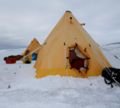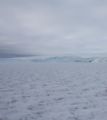Exploration ICEBLOCK
A collaborative exploration of the Chilly Continent
VIDEO to view - TRISHA RADIO's IN TO SCOTT BASE FROM OUT ON THE SEA ICE Click here and take look at this video that I've put on youtube of me doing the radio schedule call in to Scott Base. When we are out in the field we have to regularly radio in to Scott Base to let them know we are all OK. There is someone at Scott Base in the Communications room 24 hours per day, just in case there is an emergency out in the field and they need to send help. Safety is their number one priority.
our mode of transport across the sea ice - the Hagland. these wheels grip very well on that slippery sea ice.
Our polar tent - the same model that Scott used! Look how we keep the tent flaps down.
Trisha in the Scott Polar Tent (photo Luca Chiaroni)
Looking down on our tent site on the sea ice with weddell seals swimming below us!
View from our tent, Barne glacier off Mt Erebus
the Barne glacier close up. This glacier extends out into the sea and goes down about 100m
Our team trying out the HF radio from Cape Evans camp
Testing ice tide cracks and discovering frozen seaweed and starfish! Perhaps these creatures got stuck on the anchor ice and uplifted to the surface, only to be frozen and trapped!
Ice probe in action. We have to be careful of cracks in the sea ice.
Survival huddle for stormy weather. That's me waving near the back.
The original hut built by Scott at Cape Evans
Sledge and gear outside Scott's hut
Inside Scott's hut (photo Luca Chiaroni)
Where Scott slept with his deer skin sleeping bag!
Scott's table (photo Luca Chiaroni)
Lab equipment that Scott used for his science experiments (photo Luca Chiaroni)
Seal blubber stored beside the pony stables (photo Luca Chiaroni). what do you think the blubber was used for?
A hut that's lasted 100 years
Look at these three Emperor penguins we saw waddling past us!!
These emperor penguins were waddling way in from where they were meant to be and had about 70km to get to the edge of the sea ice.
It was as though the big one in the front communicated with the others, sometimes telling them to hurry up?
These guys kept together at all times. Why do you think they walked in a line?
How do these penguins survive in these extreme cold and windy conditions??
The penguins go on their way and we have to do the same!
Here it is... a Weddell seal in a dive hole!! This one must have been under the water for a long time as it kept coming up for more air. They can stay under for as long as 45minutes, phew!























